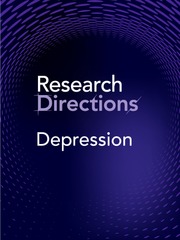Given the global prevalence of depression and other major mood disorders, the evidence of increasing rates among younger cohorts, the limited capacity of most treatment systems to respond to increasing demands for care, and the reality that services do not connect with a large proportion of those living with depressive disorders, a greater emphasis is being placed on our capacity to prevent the onset, recurrence, or persistence of these disabling conditions (Herrman et al., Reference Herrman, Patel, Kieling, Berk, Buchweitz, Cuijpers, Furukawa, Kessler, Kohrt, Maj, McGorry, Reynolds, Weissman, Chibanda, Dowrick, Howard, Hoven, Knapp, Mayberg, Penninx, Xiao, Trivedi, Uher, Vijayakumar and Wolpert2022).
The need for enhanced prevention has also been emphasized by the reality that at least half of those provided with an evidence-based medical or psychological treatment for depression have only a limited response and that at least a third respond poorly to multiple different treatments (Cuijpers et al., Reference Cuijpers, Karyotaki, Ciharova, Miguel, Noma, Stikkelbroek, Weisz and Furukawa2023; McIntyre et al., Reference McIntyre, Alsuwaidan, Baune, Berk, Demyttenaere, Goldberg, Gorwood, Ho, Kasper, Kennedy, Ly-Uson, Mansur, McAllister-Williams, Murrough, Nemeroff, Nierenberg, Rosenblat, Sanacora, Schatzberg, Shelton, Stahl, Trivedi, Vieta, Vinberg, Williams, Young and Maj2023). Further, recurrence, persistence, or progression to more complex and disabling disorders is common (Iorfino et al., Reference Iorfino, Scott, Carpenter, Cross, Hermens, Killedar, Nichles, Zmicerevska, White, Guastella, Scott, McGorry and Hickie2019). Historically, while the theoretical attractiveness of prevention was recognized, there was limited enthusiasm for specific strategies – particularly those directed to prevent ‘clinical’ depression or more serious or recurrent mood disorders.
Over the last two decades, a great deal more enthusiasm has been expressed for preventive approaches despite the relative lack of evidence for large impacts from many current approaches. That enthusiasm extends across the spectrum from universal interventions (i.e., those applied to the whole population, and even where those interventions are restricted to a particular cohort such as adolescents before the typical age of onset of depressive disorders) to other more targeted forms of prevention (Cuijpers et al., Reference Cuijpers, Smit and Furukawa2021). Conceptually, universal strategies are particularly attractive, even when the specific effect is relatively small (Skinner et al., Reference Skinner, Occhipinti, Song and Hickie2023). However, other recent findings of promoting specific psychological approaches (‘mindfulness’) universally to school students (MYRIAD trial) did not deliver substantial benefits (Kuyken et al., Reference Kuyken, Ball, Crane, Ganguli, Jones, Montero-Marin, Nuthall, Raja, Taylor, Tudor, Viner, Allwood, Aukland, Dunning, Casey, Dalrymple, De Wilde, Farley, Harper, Kappelmann, Kempnich, Lord, Medlicott, Palmer, Petit, Philips, Pryor-Nitsch, Radley, Sonley, Shackleford, Tickell, Blakemore, Team, Ukoumunne, Greenberg, Ford, Dalgleish, Byford and Williams2022).
Accumulating evidence also indicates a more positive view of the potential impacts of selective (i.e., reduction of known risk factors) and indicated (focusing on those with symptoms, but sub-threshold for disorders) prevention strategies (Cuijpers et al., Reference Cuijpers, Pineda, Quero, Karyotaki, Struijs, Figueroa, Llamas, Furukawa and Muñoz2021). A recent dynamic modelling study highlighted the relative additional benefits that may be achieved by wider application of indicated interventions compared to universal or selective approaches (Skinner et al., Reference Skinner, Occhipinti, Song and Hickie2023). With the advent of new methods for broad dissemination of such interventions (largely via digital technologies), and new targets (such as sleep-wake cycle disruptions) (Crouse et al., Reference Crouse, Carpenter, Song, Hockey, Naismith, Grunstein, Scott, Merikangas, Scott and Hickie2021; Hickie et al., Reference Hickie, Scott, Cross, Iorfino, Davenport, Guastella, Naismith, Carpenter, Rohleder, Crouse, Hermens, Koethe, Markus Leweke, Tickell, Sawrikar and Scott2019), the potential for indicated prevention at scale is a real possibility.
The discourse with regard to depression is made more complex by a number of factors including: whether the target is simply preventing depression or includes (often preceding) other mental disorders, most notably anxiety disorders; whether the focus is on primary prevention of first-episodes or includes secondary prevention of recurrence, persistence or onset of comorbid physical and mental health conditions; whether depression and other mood disorders are considered to be a homogeneous grouping as distinct from prevention of a range of different disorders requiring quite different approaches to reduction of risk; whether proposed approaches can be applied at sufficient scale to impact on the prevalence of these conditions; and whether the focus of both research and implementation should prioritize universal, selective or indicated prevention approaches.
As part of these efforts there has also been an emphasis on what specific or novel factors could be the subject of interventions (for example, childhood anxiety, insomnia and perturbations of 24-hour sleep-wake cycles in adolescents) and which specific cohorts are worthy of particular focus (for example, 11-15 year olds prior to the upsurge in onset of new cases, perinatal cohorts, specific medical conditions – for example post-stroke, post-myocardial infarct, post-COVID infection, those with strong family histories of depression, bipolar disorder or suicide). While an emphasis on such high-risk cohorts is attractive, and often feasible, this is tempered by the reality that most people within these ‘high-risk’ groups will not develop depression (Cuijpers et al., Reference Cuijpers, Pineda, Quero, Karyotaki, Struijs, Figueroa, Llamas, Furukawa and Muñoz2021). So, an additional consideration is whether other individual factors, notably polygenic risk scores (PRS) or other independent markers, may collectively prove to add substantive value to such efforts (Scott et al., Reference Scott, Crouse, Medland, Byrne, Iorfino, Mitchell, Gillespie, Martin, Wray and Hickie2023).
The potential to deploy specific psychological or behavioural interventions at scale, and in many different settings, via new digital technologies, has also underpinned new approaches to this area. Questions as to how such approaches have an impact, and in what individual or social circumstances they are most effective, are yet to be resolved.
So, the prevention of depression field is now at such a stage that key methodological, efficacy and deployment issues need to be resolved. While strong evidence exists for indicated prevention, and growing evidence for selective prevention, it is also important to differentiate studies that clearly focus on prevention of new onsets of depression (through critical longitudinal designs) from those that simply report reductions in depressive symptoms in those individuals who were initially symptomatic (Cuijpers, Reference Cuijpers2022).
How to contribute to this question
If you believe you can contribute to answering this Question with your research outputs find out how to submit in the Instructions for authors (https://www.cambridge.org/core/journals/research-directions-depression/information/author-instructions/preparing-your-materials). This journal publishes Results, Analyses, Impact papers and additional content such as preprints and ‘grey literature’. Questions will be closed when the editors agree that enough has been published to answer the Question so before submitting, check if this is still an active Question. If it is closed, another relevant Question may be currently open, so do review all the open Questions in your field.
For any further queries check the information pages (https://www.cambridge.org/core/journals/research-directions-depression/information) or contact this email ([email protected]).
Competing interests
Ian Hickie is the Co-Director, Health and Policy at the Brain and Mind Centre (BMC) University of Sydney. The BMC operates an early-intervention youth services at Camperdown under contract to headspace. He is the Chief Scientific Advisor to, and a 3.2% equity shareholder in, InnoWell Pty Ltd which aims to transform mental health services through the use of innovative technologies.





